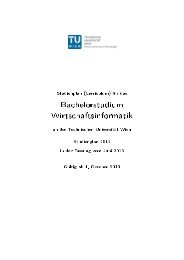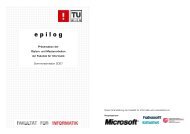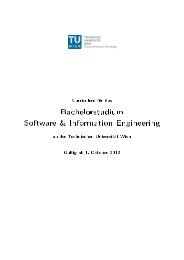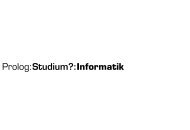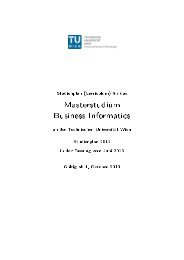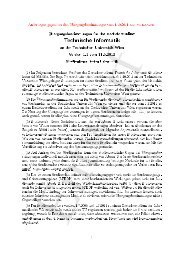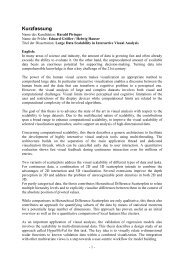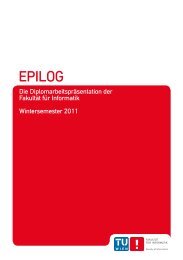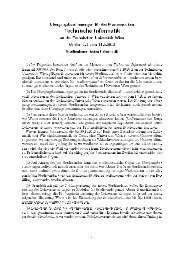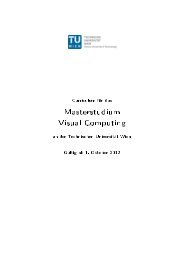Abstract-Band - Fakultät für Informatik, TU Wien - Technische ...
Abstract-Band - Fakultät für Informatik, TU Wien - Technische ...
Abstract-Band - Fakultät für Informatik, TU Wien - Technische ...
Sie wollen auch ein ePaper? Erhöhen Sie die Reichweite Ihrer Titel.
YUMPU macht aus Druck-PDFs automatisch weboptimierte ePaper, die Google liebt.
Institut <strong>für</strong> Automatisierungs- und Regelungstechnik<br />
Yaroslav Barsoukov<br />
Development of GPICP, a GPU-only registration algorithm based on Iterative<br />
Closest Point<br />
Studium: Masterstudium Software Engineering & Internet Computing<br />
BetreuerIn: Ao.Univ.Prof. Dr. Markus Vincze<br />
Der von Besl and McKay entwickelte ICP Algorithmus ist längst zum Goldstandard<br />
<strong>für</strong>s Lösen des Reqistrierungsproblems geworden. Nachdem sich die<br />
Programmierbarkeit der GPUs in der letzten Zeit erhöht hat, ist ihr paralleles<br />
Programmierungsmodel nun <strong>für</strong> ICP perfekt geeignet. Die vorliegende Arbeit<br />
setzt sich zum Ziel, eine Implementierung von ICP zu entwerfen, die völlig auf<br />
GPU ausgeführt werden könnte; die dabei entstehenden Probleme mit GPU<br />
Architektur werden gelöst, und die erhöhte Leistung wird da<strong>für</strong> benutzt, den<br />
Algorithmus selbst präziser zu machen.<br />
Bernhard Mathias<br />
Object modelling with a robot arm<br />
Studium: Masterstudium <strong>Technische</strong> <strong>Informatik</strong><br />
BetreuerIn: Ao.Univ.Prof. Dr. Markus Vincze<br />
Object learning and object recognition are general research topics in the<br />
robotics. This thesis deals with the problem of automating the learning process.<br />
A robot should be able to explore its environment and to learn new<br />
objects autonomously. For object modelling, an implementation of the V4R<br />
library (of the Vision for Robotics group, ACIN, <strong>TU</strong> Vienna) is used. A model<br />
combines image descriptors (SIFT) representing textures and point cloud<br />
descriptors (SHOT) to describe the 3-D shape of the object. The information<br />
stored in such models can be used to recognize objects in other scenarios<br />
again (even amongst many other objects). In order to get 2-D RGB as well as 3-<br />
D depth images, the Microsoft Kinect camera is used within this project. To<br />
move the objects in front of the camera, a robotic arm of the type Neuronics<br />
Katana 450 is used. A trajectory as optimally as possiple is necessary to receive<br />
a complete model. The completeness of a model can be checked with the<br />
probability sphere already implemented in V4R. The probability sphere is a<br />
platonic body where the surface consists of several triangular faces. These<br />
faces represent different viewpoints relative to the object. Colours represent<br />
the completeness of the model from the according direction. White faces<br />
indicate a high probability to detect the object from this viewpoint and black<br />
faces indicate missing viewpoints. Grey-shaded faces represent partially<br />
observed viewpoints. There are several subproblems within this project, for<br />
example, the determination of the robot arm pose within the camera<br />
coordinates (camera calibration) or the topic of how to control the arm with an<br />
optimal trajectory. Also image processing is an important topic within this<br />
87



